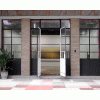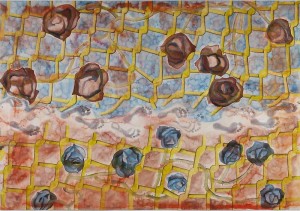 |
James Cohan Gallery, Shanghai
1/F Building 1, No.1 Lane,
170 Yue Yang Road,
Shanghai 200031, PRC CHINA map *
tel: +86 21 5466 0825
fax: +86 21 5466 0823
send email
website
|

Enlarge
|
| Francesco Clemente Solo Exhibition
|
|
| by James Cohan Gallery, Shanghai
Location: James Cohan Gallery Shanghai
Artist(s): Francesco CLEMENTE
Date: 7 Sep - 11 Nov 2012
James Cohan Gallery Shanghai is pleased to present its first solo exhibition with the internationally acclaimed artist Francesco Clemente, and the artist’s first-ever exhibition in mainland China.
Francesco Clemente, born in 1952 in Naples, Italy, is widely recognized as a defining contemporary artist for the past four decades who has established an extraordinary, singular pictorial language that draws on timeless symbols, mythologies, cultures, and philosophies. The diversity of the artist’s chosen mediums—paintings, frescos, watercolors, pastels, collage, and gouache—and the themes and subject matter of his works have been deeply informed by Clemente’s nomadic artistic life.
Since the early 1970s the artist has continually traveled between Italy and India where many of the works in this current exhibition were made. He continued to travel to India, after settling in New York with his wife and family in 1980, where Clemente quickly became a vital member of the community of artists and writers. He collaborated with close friends, notably the poets Allen Ginsberg and Robert Creeley, and in 1981, reacting against a wave of anti-painting sentiment among critical circles, Clemente initiated a series of collaborative paintings with Jean-Michel Basquiat and Andy Warhol. The openness to collaborating with other artists combined with his experimental practices contributed to Clemente becoming a rising star of the international art world. His works were soon exhibited at both Documenta 7 in 1982 and the Venice Biennale in 1988, 1993, and again in 1995. Major solo museum exhibitions followed at the Nationalgalerie Berlin (1984), Centre Georges Pompidou, Paris (1994), Solomon R. Guggenheim Museum (1999), MADRE Museum, Naples (2009), and more recently at Schirn Kunsthalle, Frankfurt (2011) and Uffizi Gallery, Florence (2011). It has been said that Clemente’s conviction in his role as an artist is a kind of universal witness of consciousness. He came of age as an artist during a time when the call for a renewal of consciousness was the anthem of the day, which also points to the origins of his artistic inclinations: “The original impulse in my life as an artist,” Clemente has said, “was to write and to break from writing into image.” He has since then pursued arresting and indelible images which bring about an increased realization of the need to break with established notions of Self in order to expand awareness. This imperative, which continues, and his unflagging interest in philosophy and spirituality took Clemente to India for the first time in 1973. He would spend more than half of the 1970s, at irregular intervals, in the southern city of Madras, present day Chennai, and traveled extensively throughout the country. It was not long before Clemente set up a studio and had begun collaborating with local artists and exchange ideas with members of the Theosophical Society there. It can also be said that Clemente’s work and life continues to expands on multilayered records of experience, each place having its own influence on the works created at any given location, becoming an embarkation point for an ongoing visual memoir that encompasses simultaneously a profoundly personal and yet universal journey.
The works in this exhibition focus on Clemente’s masterful use of watercolor. On view are watercolors made in Varanasi, India in 2008, as well as recent large-scale watercolors created at the artist’s studio in New York last year in 2011. The Varanasi watercolors were made using as their basis cut-out stenciled silhouettes—open palms, feet, bells, vases, wings; a heart-shaped or pelvic shape or two human heads in mirrored profile. The scholar and critic Jyotindra Jain, whose engagement with Clemente’s work in India goes back for the past twenty years, has written extensively on these specific watercolors stating “Cutting out a stencil in the form of the outermost contouring elements, Clemente first replicated the silhouette of each of these forms on four or more sheets of paper. Empty of any content, these hollow forms provided a wondrous space to be filled with a repertoire of images—floating, melting, transforming, definite or tentative, single or in combination; pleasant or disquieting—stemming from his nebulous imagistic world.” Clemente is a true master of seriality, as Jain also cites, “who is fascinated by the literary and musical technique of improvisation on a theme.” These works on a formal level convey ideas of symmetry and duality, but also give space to intimate reflection, agility, and fluid gracefulness. The images of the palms and feet have a long tradition in both Buddhist and Hindu cultures as divine symbols of one's destiny, auspiciousness and prosperity.
The three large-scale watercolors in this exhibition, created in Clemente’s New York studio in 2011, all share a distinctive, repeated element and image: the actual footprints of the artist leaving a trail or pathway along the mid-center or horizon line of each work. Each watercolor also suggests seasonal references and specific terrain: a monolithic stone cavern foregrounds a wintry blue and densely clouded sky; in another work the viewer looks through a chain-linked fence suggesting autumn and confinement, where long stemmed flowers or vines are intertwined within the wire mesh; the third depicts a vessel, resembling a small boat, containing a single lotus blossom as three phases of the moon hover above in what appears to be the same vessel suspended upside-down. In each of these large scale works the artist’s footprints follows on a similar course across the work's surface, conveying the artist’s continuous journey, the passage of time and memory, moving from place to place. It is this constant, ongoing invention and reinvention of such extraordinary and penetrating images that has sustained Clemente’s visionary lexicon.
Rarely exhibited, but also on view, will be three ceramic vases the artist made in 2006 and 2008 at his studio located in the New Mexico desert just north of Taos, New Mexico. These vases, glazed with images and motifs not entirely unrelated to the watercolors in this exhibition, relate to Clemente’s long interest in and knowledge of tribal art, religious sculptures, as well as reliquaries or vessels for sacred objects. |
|
|
|
|
